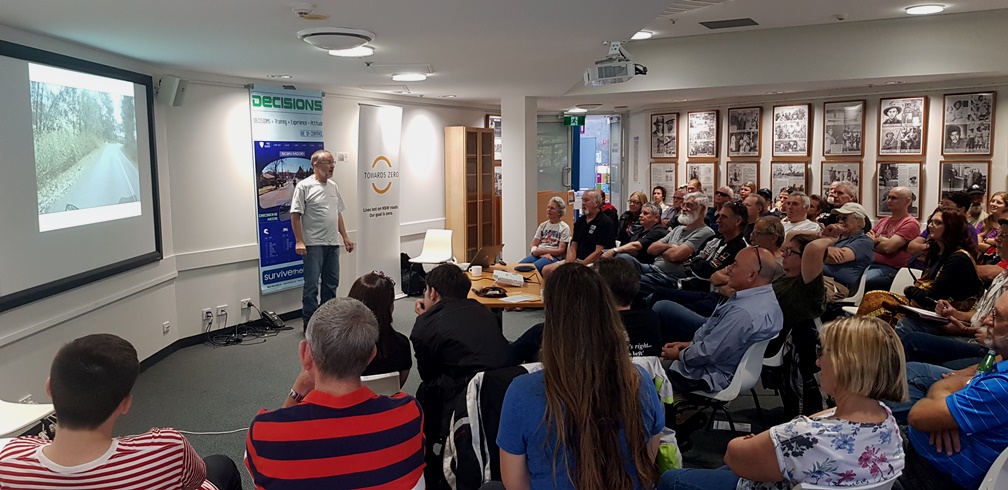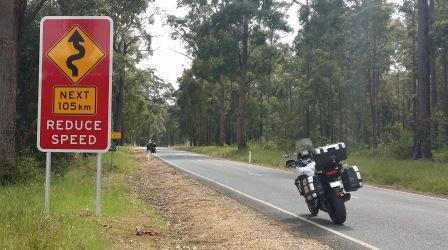Australia wide statistics are provided by the Bureau of Infrastructure, Transport, Regional Development and Communications website. A quick look at the Bureau of Transport and Infrastructure data for NSW shows motorcycle riders are continuing the good job of having fewer crashes.
The latest NSW motorcycle and scooter registration, licensing and crash data is available on the Transport for NSW, NSW Centre for Road Safety website.
The downward trend in fatalities is due to riders improving their skills combined with improvements with tyres, brakes, electronic stability and overall engineering.
Detailed analysis is conducted by professional researchers and published from time to time. For example:
Characteristics of motorcycle riders in NSW.
Motorcycle crash risk factors – NSW study
We regularly review this data to update workshops and develop our new videos.
We also review research into a range of other issues. Here are links for further reading regarding what is referred to as “Inattention Blindness”:
- Driver and rider distraction – research paper
- Inattentional Blindness – wikipedia
- Inattention blindness – research paper
Crash Data For NSW for 2011
The 2011 data was the last year we were able to provide a detailed analysis of the crash data.
The crash data for the period January 1 to December 31 2011 was supplied by the Centre for Road Safety, Transport for NSW, in December 2012.
In the calendar year of 2011, there were 2,803 crashes recorded by Police that involved powered 2 wheel vehicles.
- This included 44 crashes that involved mopeds and 5 crashes with mini bikes.
- Only 2 of the moped crashes are included in this summary as they also involved a motorbike.
- The mini bike crashes are not included as they did not involve another motorbike or scooter.
Several crashes include unknown elements such as age of the rider and the speed zone where the crash occurred. As a result there are minor discrepancies between the totals in each category reported.
In 2011 there were 483,662 current motorcycle rider licences.
A total of 2,772 riders were involved in crashes in 2011:
- The rider was at fault in 1,727 of these crashes.
- A total of 47 riders and 4 pillion passengers were killed.
- Another 2,420 riders and 101 pillion passengers were injured.
- Riders were at fault in crashes that injured 36 pedestrians and 7 pedal cycle riders.
- Riders were at fault in the death of 2 pedestrians.
More details are provided in the pdf document.
Click on this link crash data to download the full summary.
Crash Data For NSW for 2010
The crash data for the period January 1 to December 31 2010 was supplied by the Centre for Road Safety, Transport for NSW.
The following summary covers crashes that involved powered 2 wheel vehicles (Motorcycle, Scooter ) in 2010 in NSW.
There was a total of 2,721 crashes involving a powered 2 wheeled vehicle (P2WV) in 2010.
These crashes included 322 rear end crashes. Over half (169) of these crashes involved the bike running into the back of the other vehicle
70% (1,905) crashes were on roads with a speed limit of up to 60 kph and only 12% (315) were on roads with a speed limit of 100-110 kph. It’s the commuter roads and residential roads that we are having trouble with.
62% (1,687) of the crashes had the rider (us) at fault
So let’s just look at those crashes where we were at fault.
64% (1,077) of our at-fault crashes were single vehicle collisions. It was simply our own mistake. And it was not the wet weather – only 122 occurred when it was raining.
75% (804) of our single vehicle collision were “rollover” crashes, many at intersections. The category “rollover” includes a range of factors. In some of these crashes the bike fell over at the end of a skid and in other crashes the bike fell over and then slid. Plus, the question of whether the front tyre or the rear tyre lost traction cannot be answered.
These crash statistics repeat every year – the message is clear
Motorcycle riders can reduce the overall motorcycle crash rate by nearly 30% if we simply stop falling off due to our own mistakes – no one else is involved.
We can reduce our crash rate by another 6% if we simply stop running into the back of other vehicles.
THAT’S MORE THAN ONE THIRD THE CRASHES EACH YEAR
How do you stop falling off? Start by learning how to brake properly and learning how to corner properly. Practice the basics of –
– look where you are going,
– brake BEFORE the corner, and
– remember it’s a public road – not a racetrack.
The RMS messages we see on the big variable signs say “Slow Down On Corners” – what they should say is “Slow Down BEFORE the Corner”
How do you stop running into the back of other vehicles? This is really easy.
Don’t ride so close to the other vehicles. Position your bike so you can see what is ahead of the other vehicles.
Two good ideas from the learner and provisional rider guides are to:
– maintain the “3 second gap” following distance and
– look ahead of the vehicles in front so you have a clear 5 seconds of forward vision.
Every ride is a chance to learn new things about managing traffic and staying in control when you are on your own.
Survive The Ride





